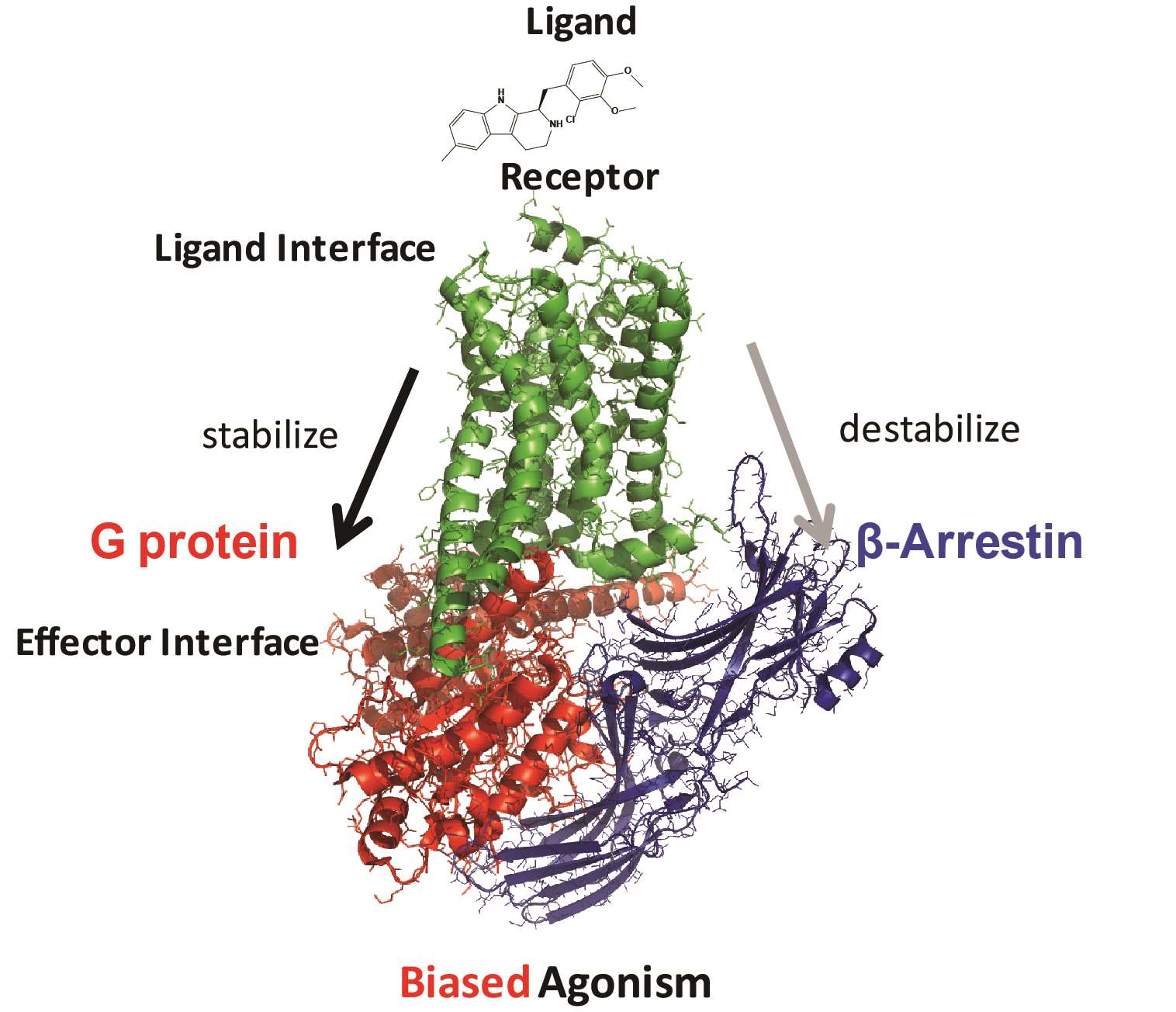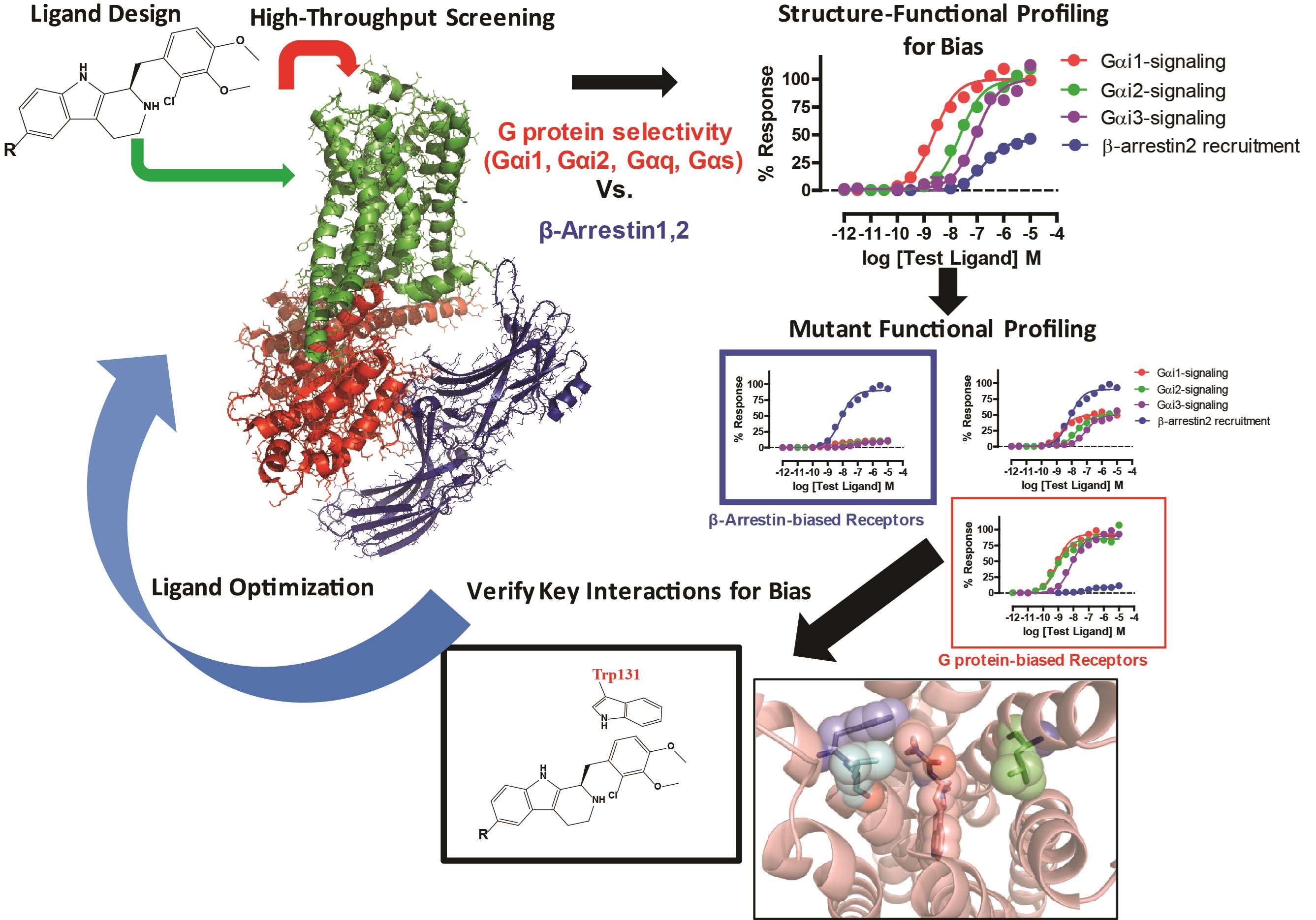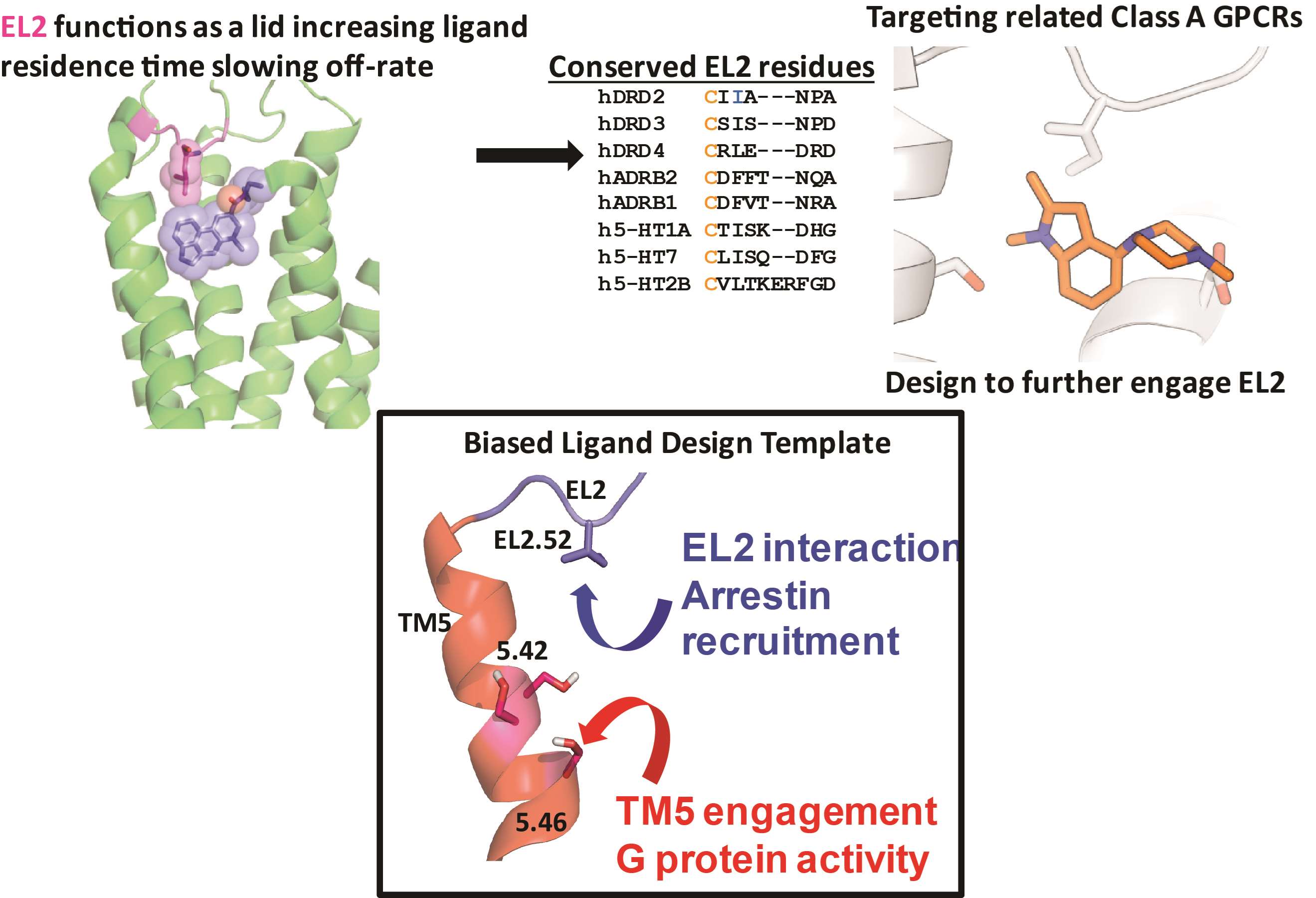
John D. McCorvy, PhD
Assistant Professor
Locations
- Cell Biology, Neurobiology & Anatomy
Contact Information
Education
PhD, Medicinal Chemistry and Molecular Pharmacology, Purdue University, 2012
BA, Biochemistry and Psychology, Texas Tech University, 2005
Research Experience
- Antipsychotic Agents
- beta-Arrestins
- Binding Sites
- Central Nervous System Stimulants
- Crystallography, X-Ray
- Dopamine Agonists
- Drug Design
- Drug Discovery
- Hallucinogens
- Kinetics
- Ligands
- Lysergic Acid Diethylamide
Research Interests
The McCorvy lab studies G protein-coupled receptor (GPCR) recognition and signaling involved in various psychoactive and physiological effects present in human disease, with an emphasis on psychedelic, antipsychotic, and antidepressant drug action. In particular, the lab studies the phenomenon known as “biased signaling” or “functional selectivity”, whereby drugs for any given receptor can exhibit a spectrum of signal transduction pathways, G protein-dependent (e.g. Gq, Gs, Gi) or G protein-independent (e.g. β-arrestin). The ultimate aim of the lab is to profile, delineate, and exploit key signal transduction pathways using a combination of chemical biology, structure-based drug design, medicinal chemistry and high-throughput screening (HTS) technologies.

Recent Discoveries
With the discovery of GPCR functional selectivity, high-throughput screening (HTS) and virtual ligand screening (VLS) technologies have yielded novel biased ligands for the µ-opioid receptor (Manglik et al. Nature 2015), dopamine D2 (Chen, McCorvy et al. J Med Chem 2016) and D4 (Wang et al. Science 2017), and serotonin 5-HT2C (Cheng, McCorvy et al. J Med Chem 2016) receptors. An on-going question, however, is exactly how biased ligands translate information to the receptor binding pocket to prefer or engage specific intracellular effectors (e.g. G proteins, β-arrestins) leading to ligand bias. Using a structure-based approach, major determinants of ligand bias in the binding pocket (e.g. extracellular loop 2) have been discovered and elucidated with the structure of LSD in the 5-HT2B receptor (Wacker, Wang, McCorvy et al. Cell 2017), an area exploited for other aminergic GPCRs (McCorvy, Butler et al. Nature Chemical Biology 2018) to yield novel β-arrestin biased ligands as potential antipsychotics and antidepressants, devoid of hallucinogenic potential. Current mapping of key binding pocket areas of GPCRs has led to the identification of other putative ‘allosteric sites’ responsible for ligand bias for the 5-HT2B receptor (McCorvy, Wacker, Wang et al. Nature Structural and Molecular Biology 2018). These semi-conserved structural motifs incorporating extracellular regions of the binding pocket can be exploited for a host of new pharmacological probes (biased positive allosteric modulators) to elucidate structural mechanisms ultimately responsible for ligand bias. New probes and understanding into the structural determinants of GPCR biased signaling will serve as a blueprint for a new generation of novel rationally-designed biased small molecule therapeutics for a host of diseases.
Areas of focus
Profiling of Psychoactive Drugs for Biased Signaling at Aminergic GPCRs
A key aim of the lab is to “uncover” biased signaling profiles at a plethora of aminergic (serotonin, dopamine, and adrenergic) GPCRs. Typically, drugs such as antipsychotics and antidepressants have several targets, a phenomenon known as “polypharmacology”, including acting as mixed agonists or antagonists at a host of aminergic receptors (D2, 5-HT2A, 5-HT2C, α2A), many at which can lead to serious side-effects (5-HT2B and cardiac valvulopathy). However, not all signal transduction pathways for these receptors have been extensively profiled for ligand bias, including a key non-canonical effector, β-arrestin, which can cause desensitization, internalization, and G protein-independent signaling in a time-dependent manner. Therefore, by understanding GPCR signal transduction kinetics, “signatures” of psychoactive drugs that lead to side-effects can be identified, exploited or avoided for safer therapeutics for depression, schizophrenia, and mood disorders (see McCorvy et al. J Psychopharmacology 2016).

Determining Biased Ligand Recognition Structure-Function Relationships
With the recent explosion in GPCR structural biology, a host of techniques are available to elucidate distinct binding modes that lead to biased agonism (see McCorvy, Wacker, Wang et al. Nature Structural and Molecular Biology 2018). One of the best approaches is to use GPCR structures to pair ligand structure-activity-relationships (SAR) with pharmacological assays measuring several signaling pathways to construct structure-functional selectivity relationships (SFSRs) and to identify the key chemical substituent(s) that ‘direct’ biased signaling via binding pocket residue engagement. Using extensive mutagenesis and analog design, molecular determinants of biased agonism can be revealed to understand binding poses that lead to switch in effector (G proteins, β-arrestin) preference.

Design of novel ligands or probes with a new mechanism of action
Identification of key GPCR motifs (e.g. EL2, figure 3) important for directing effector engagement has been critical for the design of novel probes as potential biased therapeutics. A key area of interest is using synthetic drug design to target regions specific for β-arrestin bias (McCorvy, Butler et al. Nature Chemical Biology 2018), or effectively to avoid them using a constructed drug design template applicable for aminergic GPCRs. Together with identifying conserved binding mode areas of the receptor, a complex ‘biased’ polypharmacology (Peng, McCorvy et al. Cell 2018) can be constructed to yield G protein or β-arrestin bias across a spectrum of important aminergic GPCRs. In addition, potential allosteric sites have been identified as an area to develop new ‘biased’ positive or negative allosteric modulators.

Publications
-
(Kelly TJ, Bonniwell EM, Mu L, Liu X, Hu Y, Friedman V, Yu H, Su W, McCorvy JD, Liu QS.) Neuropsychopharmacology. 2024 Apr;49(5):854-863 PMID: 37752222 PMCID: PMC10948882 SCOPUS ID: 2-s2.0-85172244117 09/27/2023
-
Functional profiling of the G protein-coupled receptor C3aR1 reveals ligand-mediated biased agonism.
(Rodriguez P, Laskowski LJ, Pallais JP, Bock HA, Cavalco NG, Anderson EI, Calkins MM, Razzoli M, Sham YY, McCorvy JD, Bartolomucci A.) J Biol Chem. 2024 Jan;300(1):105549 PMID: 38072064 PMCID: PMC10796979 SCOPUS ID: 2-s2.0-85181819143 12/11/2023
-
Identification of 5-HT2A receptor signaling pathways associated with psychedelic potential.
(Wallach J, Cao AB, Calkins MM, Heim AJ, Lanham JK, Bonniwell EM, Hennessey JJ, Bock HA, Anderson EI, Sherwood AM, Morris H, de Klein R, Klein AK, Cuccurazzu B, Gamrat J, Fannana T, Zauhar R, Halberstadt AL, McCorvy JD.) Nat Commun. 2023 Dec 15;14(1):8221 PMID: 38102107 PMCID: PMC10724237 SCOPUS ID: 2-s2.0-85179903706 12/16/2023
-
Beyond the 5-HT2A Receptor: Classic and Nonclassic Targets in Psychedelic Drug Action.
(Cameron LP, Benetatos J, Lewis V, Bonniwell EM, Jaster AM, Moliner R, Castrén E, McCorvy JD, Palner M, Aguilar-Valles A.) J Neurosci. 2023 Nov 08;43(45):7472-7482 PMID: 37940583 PMCID: PMC10634557 SCOPUS ID: 2-s2.0-85176431720 11/09/2023
-
(Tosh DK, Calkins MM, Ivancich MS, Bock HA, Campbell RG, Lewicki SA, Chen E, Gao ZG, McCorvy JD, Jacobson KA.) Eur J Med Chem. 2023 Nov 05;259:115691 PMID: 37562117 PMCID: PMC10529765 SCOPUS ID: 2-s2.0-85166945754 08/11/2023
-
Molecular insights into GPCR mechanisms for drugs of abuse.
(Sanchez-Reyes OB, Zilberg G, McCorvy JD, Wacker D.) J Biol Chem. 2023 Sep;299(9):105176 PMID: 37599003 PMCID: PMC10514560 SCOPUS ID: 2-s2.0-85171147748 08/21/2023
-
(Balapattabi K, Yavuz Y, Jiang J, Deng G, Mathieu NM, Ritter ML, Opichka MA, Reho JJ, McCorvy JD, Nakagawa P, Morselli LL, Mouradian GC Jr, Atasoy D, Cui H, Hodges MR, Sigmund CD, Grobe JL.) Cell Rep. 2023 Aug 29;42(8):112935 PMID: 37540598 PMCID: PMC10530419 SCOPUS ID: 2-s2.0-85169503465 08/04/2023
-
Mu-opioid receptor selective superagonists produce prolonged respiratory depression.
(Malcolm NJ, Palkovic B, Sprague DJ, Calkins MM, Lanham JK, Halberstadt AL, Stucke AG, McCorvy JD.) iScience. 2023 Jul 21;26(7):107121 PMID: 37416459 PMCID: PMC10320493 07/07/2023
-
A non-hallucinogenic LSD analog with therapeutic potential for mood disorders.
(Lewis V, Bonniwell EM, Lanham JK, Ghaffari A, Sheshbaradaran H, Cao AB, Calkins MM, Bautista-Carro MA, Arsenault E, Telfer A, Taghavi-Abkuh FF, Malcolm NJ, El Sayegh F, Abizaid A, Schmid Y, Morton K, Halberstadt AL, Aguilar-Valles A, McCorvy JD.) Cell Rep. 2023 Mar 28;42(3):112203 PMID: 36884348 PMCID: PMC10112881 SCOPUS ID: 2-s2.0-85149448597 03/09/2023
-
Psychedelics promote neuroplasticity through the activation of intracellular 5-HT2A receptors.
(Vargas MV, Dunlap LE, Dong C, Carter SJ, Tombari RJ, Jami SA, Cameron LP, Patel SD, Hennessey JJ, Saeger HN, McCorvy JD, Gray JA, Tian L, Olson DE.) Science. 2023 Feb 17;379(6633):700-706 PMID: 36795823 PMCID: PMC10108900 SCOPUS ID: 2-s2.0-85148258353 02/17/2023
-
(Elmansi AM, Eisa NH, Periyasamy-Thandavan S, Kondrikova G, Kondrikov D, Calkins MM, Aguilar-Pérez A, Chen J, Johnson M, Shi XM, Reitman C, McGee-Lawrence ME, Crawford KS, Dwinell MB, Volkman BF, Blumer JB, Luttrell LM, McCorvy JD, Hill WD.) ACS Pharmacol Transl Sci. 2023 Jan 13;6(1):22-39 PMID: 36659961 PMCID: PMC9844133 01/21/2023
-
(Tosh DK, Calkins MM, Ivancich MS, Bock HA, Campbell RG, Lewicki SA, Chen E, Gao ZG, McCorvy JD, Jacobson KA.) European Journal of Medicinal Chemistry. 5 November 2023;259 SCOPUS ID: 2-s2.0-85166945754 11/05/2023



